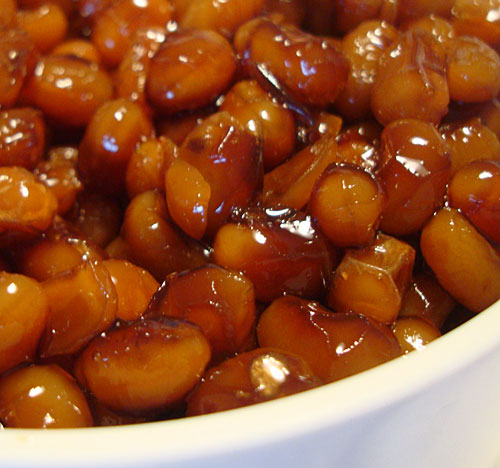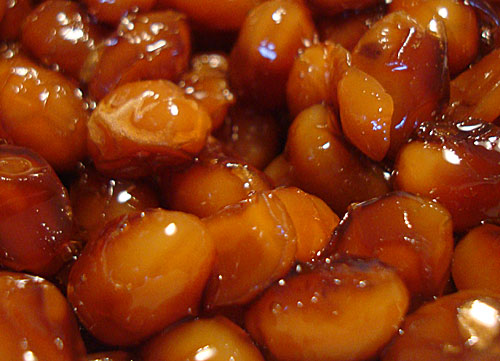Budo Mame or Budoh Mame: Sweet-salty soy beans (Bento filler)

There are many recipes for stewed or simmered beans in Japanese cooking, but this is one of the simplest, and I'm fairly sure, one of the oldest recipes in existence. It traditionally only uses three ingredients -- soy beans, sugar and soy sauce -- but I've added a little salt too since I like the saltiness to be a bit more assertive to balance the sweetness. The beans have a unique, chewy texture that is unlike any other bean dish I've ever had. The soy beans become almost caramelized, yet are not cloyingly sweet.
The name budo mame means 'grape beans'. I'm not totally sure what it means, but it probably means that the beans take on a shiny appearance rather like grapes. They do indeed look like black grapes when made with black soy beans (kuromame), but here I've made them with regular white or light brown soy beans, which are a lot easier to get for most people.
Just a spoonful or so tucked into the corner of your bento box makes a nice change of pace, even a mini-dessert of sorts (see "chopstick rest" below). And of course, it's packed with protein.
A pressure cooker is highly recommended to make this, but you can cook it without one too.
Recipe: Budo Mame or Budoh Mame

Makes about 3 cups cooked
- 2 cups dry soy beans
- 1 1/2 cups sugar
- 2 tablespoons soy sauce
- 1 teaspoon sea salt
If using a pressure cooker: Rinse the soy beans. Put in the pressure cooker and add enough water so that it comes up to about 2 inches / 5cm above the beans.
Put a small, heatproof plate or the steamer rack that came with your cooker on top of the beans. This prevents any loose soybean skins from flying up to the underside of lid and clogging up the steam vents (this can lead to a lot of liquid bubbling out from the top, which gets rather messy).
Put the lid on, lock and bring up the pressure, following your pressure cooker's instructions. Lower the heat, and cook under pressure for 20 to 25 minutes. Release the pressure and open the lid. Skim off any loose skins.
If using a conventional pot: Rinse the soy beans, and soak in enough water to cover for at least 12 hours. Drain the soaking water, and put the beans in a heavy-bottomed pot, with enough fresh water added to come up to about 2 inches / 5cm above the beans.
Bring the pot up to a boil, and lower the heat so that it's just simmering. Cook for 4-5 hours or until the beans are soft, and smush easily when you take one between your thumb and forefinger and press. Skim off any loose skins.
For both methods: After the soy beans have been cooked, scoop out some of the cooking liquid if needed, so that the beans are only covered with about an inch / 2.5cm of liquid. Add the sugar, and simmer slowly for about an hour to 90 minutes. At some point the beans will start to shrink and turn quite dark and caramelized looking. When this happens, add the soy sauce and salt, stir, and simmer for 15-20 minutes more. If the liquid boils away too much, add some of the reserved cooking liquid.
Leave to cook in the cooking liquid. The beans improve in flavor and texture when they are cooled.
The beans will keep in the refrigerator for at least a week.
Extras
Lucky beans
Beans are considered to be very lucky in Japanese foodlore, so the black kind of budo mame often make an appearance as part of osechi, the New Year's feast foods.
Chopstick rest dishes
Japanese meals usually do not have a sweet or dessert course per se (sweet things are reserved for in-between snack time, or to eat with tea). However, many meals, especially bentos, have a little side dish with a contrasting flavor or texture from the main dishes. This contrasting side dish is called a hashi yasume (箸休め) or "chopstick rest". (This is not the same as a hashi oki (箸置き)), the the little object usually made of ceramic that chopsticks are rested on during a meal.) These sweet-salty beans are a perfect example of a "chopstick rest"; sweet enough to almost be a dessert, yet still salty enough to eat with rice.
Pressure cooker in my luggage
I actually hauled a pressure cooker all the way from Switzerland to Japan in my luggage for this visit. As I've written about previously, pressure cookers are ubiquitous in Switzerland, and well made to boot by manufacturers like Kuhn Rikon. While pressure cookers have really been gaining in popularity in Japan (they are all over the shopping channels on TV), they seem to be much more expensive for similar quality.
I've been telling my mother that she needs pressure cooker for years, since she loves to cook beans so much. She's been a bit afraid of them, as many people are, but after trying it out to make these classic sweet-salty soy beans, she is convinced. With a pressure cooker, it cooked up in about 2 hours. Without, it would have taken all day. Pressure cookers are well suited for many traditional Japanese dishes, so I think my mother is really going to enjoy hers!
If you enjoyed this article, please consider supporting this site by becoming my patron via Patreon.
